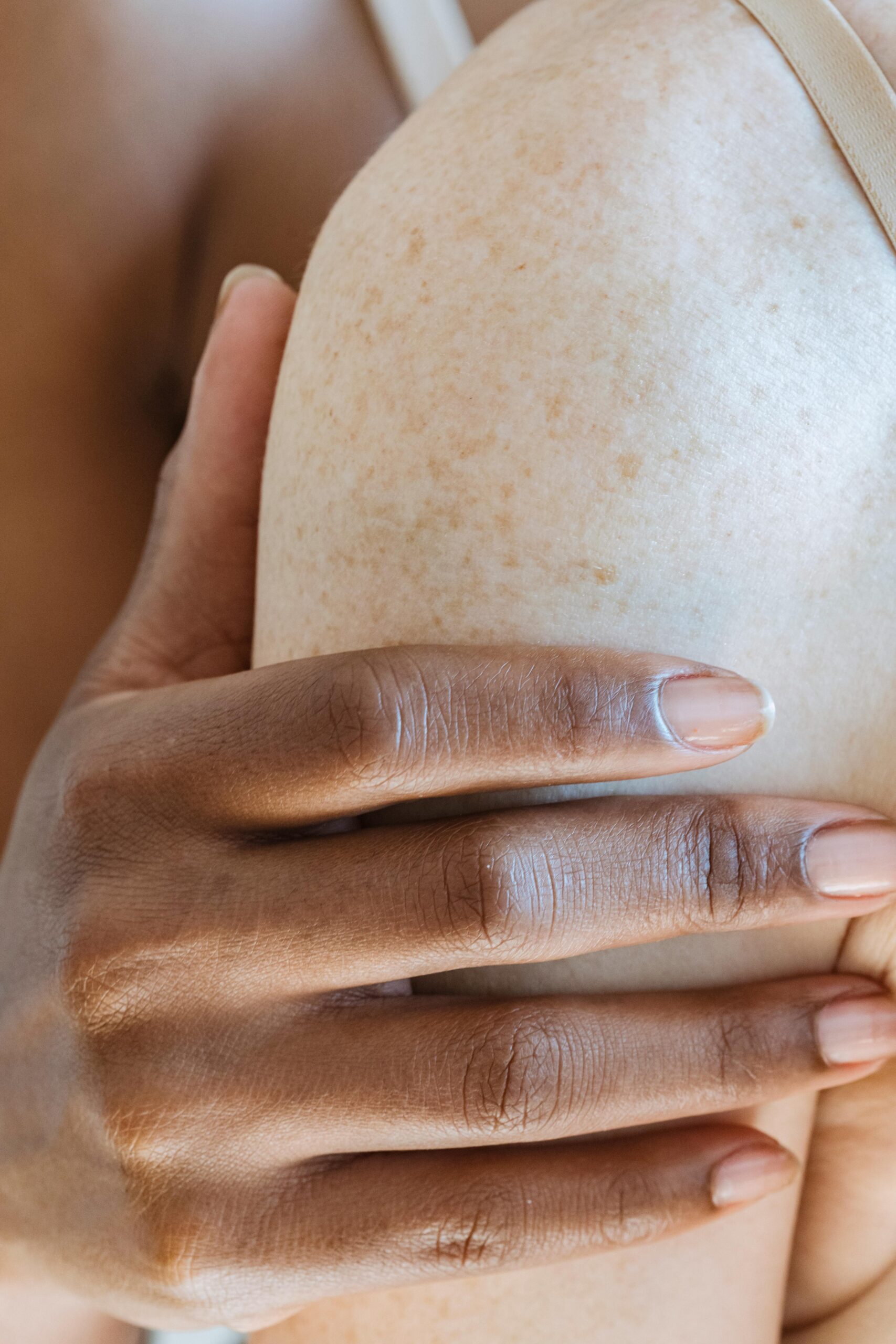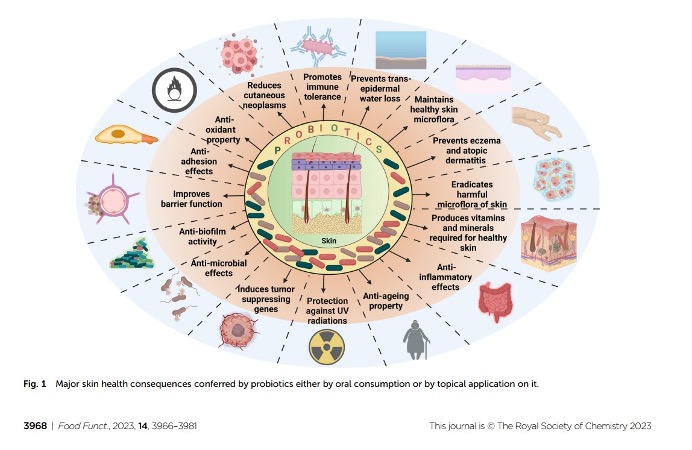“Here are the main takeaways from this blog. Scroll down for the full story!”
- Supports a healthy skin microbiome: Postbiotics help maintain a balanced skin
microbiome, which may play a role in supporting overall skin health. - Promotes hydration: Postbiotics can help improve skin moisturization, elasticity, and
the appearance of fine lines and pores. - Helps manage skin irritation: Postbiotics may help soothe irritation and support the
skin’s natural healing processes, which can be beneficial for skin conditions like acne. - Provides antioxidant support: Postbiotics may help protect the skin from
environmental stressors, such as free radicals and UV damage, which can contribute to
the appearance of aging.
Together, postbiotics can help support overall skin health, contributing to a resilient and smooth
skin.
Introduction
Our skin is not only aDected by what we put on it, but also by what’s happening inside our bodies,
particularly in our gut. This connection between gut health and skin appearance is known as the
gut-skin axis1. Emerging research has shown that a healthy gut microbiome can have a positive
impact on our skin. Our microbiome consists of beneficial bacteria, named probiotics. These
probiotics can produce so-called postbiotics: beneficial compounds that are known for their
health eDects. Postbiotics have been found to provide a range of benefits for the skin, making
them an important part of a skincare routine that works from the inside out. YIXIY is a vitality
product which contains both natural post- and probiotics. In this blog, we will explore four
benefits of postbiotics for our skin!

1. Balancing the skin microbiome
Did you know that the skin is the largest organ of our body and that it even has its own
microbiome? Skin microbiota contains over 800 diverse types of microbes2. A single square
centimetre of the human skin can contain up to one billion microorganisms3. Postbiotics can
promote the growth of beneficial bacteria while inhibiting harmful ones, maintaining a balanced
skin microbiome4,5. This balance is crucial for preventing skin infections and maintaining overall
skin health. Disbalance of the skin microbiome, known as dysbiosis, has been associated with
several skin conditions such as eczema and psoriasis6. By supporting a healthy, balanced
microbiome, postbiotics contribute to a resilient and healthy skin microbiome.
2. Boosting skin hydration
Postbiotics can be a game-changer for skin hydration. Healthy skin hydration is essential for
maintaining a smooth and youthful appearance, as well as protecting against irritation. Studies
have shown that postbiotics from S. Thermophilus, L. casei, and L. Rhamnosus can help increase
skin moisturization 7,8 and promote better elasticity7. These postbiotics have also been linked to
reducing the appearance of wrinkles and minimizing pore size7. Additionally, postbiotics from B.
Longum are known to strengthen the skin barrier, while also decreasing skin sensitivity and
roughness 9. Notably, higher concentrations of propionate, another postbiotic, have been found in
people with well-hydrated skin, suggesting that maintaining propionate levels could support a
moisturized, healthy skin. Overall, postbiotics play a relevant role in supporting skin hydration,
contributing to a healthy appearance.
3. Calming the skin: Reducing inflammation and aiding wound recovery
Skin conditions like eczema, acne, and psoriasis often come with inflammation, which can cause
redness, irritation, and discomfort. Postbiotics can help manage inflammation in the body10-15,
soothing irritated skin. For example, postbiotics from L. rhamnosus have been shown to decrease
redness of the skin8. Additionally, postbiotics like peptidoglycans and exopolysaccharides play a
role in supporting wound healing4, helping the skin recover and stay healthy. In the case of acne,
postbiotics like pyruvic acid, a specific postbiotic, has been shown to reduce skin greasiness
through peelings16. By targeting both inflammation and skin healing, postbiotics provide a natural
solution to boost your skin’s health.
4. Antioxidant protection: Shielding skin from damage and aging
Our skin is constantly exposed to environmental toxins, UV rays, and free radicals that can break
down collagen, a key protein that keeps our skin firm and elastic. Reductions in collagen can lead
to signs of aging like wrinkles and rough skin texture. Luckily, some postbiotics support powerful
antioxidant protection, helping to shield the skin from this damage17. Postbiotics from the
fermentation by lactic acid bacteria in kimchi have been shown to block enzymes that break down
collagen18, helping to keep the skin firm and youthful. Another postbiotic named glycolic acid
boosts collagen production, helping repair skin damaged by the sun19. It also improves skin
texture and reduces signs of hyperpigmentation18 and aging, such as wrinkles and roughness18.
Additionally, glycolic acid has been reported to help with acne21. Moreover, application of butyric
acid, yet another postbiotic, to the skin reduced inflammation caused by UV radiation22. Together,
these postbiotics help protect and rejuvenate the skin.
Summary
Postbiotics oDer several potential benefits for skin health by supporting the skin barrier, reducing
inflammation, and providing antioxidant protection. These postbiotics can help promote a
balanced skin microbiome, which is important for overall skin health. By helping to maintain skin
hydration, soothing irritation, and protecting the skin from environmental stressors, postbiotics
can contribute to a healthier, more resilient skin. Incorporating postbiotics into your skincare
routine may enhance your skin’s natural defenses and overall appearance, nourishing your skin
from within.
The claims made in this article have not been evaluated by the Food and Drug
Administration (FDA). These products are not intended to diagnose, treat, cure, or prevent
any disease.

Figure 1 Effects of probiotics on the skin either by oral consumption or topical application. Source: Rawal, S., & Ali, S. A. (2023). Probiotics and postbiotics play a role in maintaining dermal health. Food & Function, 14(9), 3966-3981. Note: License permission is pending, please do not copy or distribute this image
References
1. Pessemier, B. De, Grine, L., Debaere, M., Maes, A., Paetzold, B., and Callewaert, C. (2021). Gut– Skin Axis: Current Knowledge of the Interrelationship between Microbial Dysbiosis and Skin Conditions. Microorganisms 9, 353. https://doi.org/10.3390/MICROORGANISMS9020353.
2. Timm, C.M., Loomis, K., Stone, W., Mehoke, T., Brensinger, B., Pellicore, M., Staniczenko, P.P.A.,
Charles, C., Nayak, S., and Karig, D.K. (2020). Isolation and characterization of diverse microbial
representatives from the human skin microbiome. Microbiome 8. https://doi.org/10.1186/S40168-
020-00831-Y.
3. Cooper, A.J., Weyrich, L.S., Dixit, S., and Farrer, A.G. (2015). The skin microbiome: Associations
between altered microbial communities and disease. Australasian Journal of Dermatology 56,
268–274. https://doi.org/10.1111/AJD.12253.
4. Rawal, S., and Ali, S.A. (2023). Probiotics and postbiotics play a role in maintaining dermal health.
Food Funct 14, 3966–3981. https://doi.org/10.1039/D3FO00152K.
5. De Almeida, C.V., Antiga, E., and Lulli, M. (2023). Oral and Topical Probiotics and Postbiotics in Skincare and Dermatological Therapy: A Concise Review. Microorganisms 2023, Vol. 11, Page 1420 11, 1420. https://doi.org/10.3390/MICROORGANISMS11061420.
6. Lee, H.J., and Kim, M. (2022). Skin Barrier Function and the Microbiome. International Journal of Molecular Sciences 2022, Vol. 23, Page 13071 23, 13071. https://doi.org/10.3390/IJMS232113071.
7. Catic, T., Pehlivanovic, B., Pljakic, N., and Balicevac, A. (2022). The Moisturizing Ecicacy of a Proprietary Dermo-Cosmetic Product( CLS02021) Versus Placebo in a 4-week Application Period. https://doi.org/10.5455/medarh.2022.76.108-114.
8. Cui, H., Feng, C., Zhang, T., Martínez-Ríos, V., Martorell, P., Tortajada, M., Cheng, S., Cheng, S., and Duan, Z. (123AD). Ecects of a lotion containing probiotic ferment lysate as the main functional ingredient on enhancing skin barrier: a randomized, self-control study. Scientific Reports | 13, 16879. https://doi.org/10.1038/s41598-023-43336-y.
9. Guéniche, A., Bastien, P., Ovigne, J.M., Kermici, M., Courchay, G., Chevalier, V., Breton, L., and Castiel-Higounenc, I. (2010). Bifidobacterium longum lysate, a new ingredient for reactive skin. Exp Dermatol 19, e1–e8. https://doi.org/10.1111/J.1600-0625.2009.00932.X.
10. He, J., Zhang, P., Shen, L., Niu, L., Tan, Y., Chen, L., Zhao, Y., Bai, L., Hao, X., Li, X., et al. (2020). Short-Chain Fatty Acids and Their Association with Signalling Pathways in Inflammation, Glucose and Lipid Metabolism. Int J Mol Sci 21, 1–16. https://doi.org/10.3390/IJMS21176356.
11. Acevedo-Román, A., Pagán-Zayas, N., Velázquez-Rivera, L.I., Torres-Ventura, A.C., and GodoyVitorino, F. (2024). Insights into Gut Dysbiosis: Inflammatory Diseases, Obesity, and Restoration
Approaches. International Journal of Molecular Sciences 2024, Vol. 25, Page 9715 25, 9715.
https://doi.org/10.3390/IJMS25179715.
12. Rocha-Ramírez, L.M., Pérez-Solano, R.A., Castañón-Alonso, S.L., Moreno Guerrero, S.S., Ramírez
Pacheco, A., García Garibay, M., and Eslava, C. (2017). Probiotic Lactobacillus Strains Stimulate
the Inflammatory Response and Activate Human Macrophages. J Immunol Res 2017.
https://doi.org/10.1155/2017/4607491.
13. Baglama, Š.Š., and Trčko, K. (2022). Skin and gut microbiota dysbiosis in autoimmune and
inflammatory skin diseases. Acta Dermatovenerol Alp Pannonica Adriat 31, 105–109.
https://doi.org/10.15570/ACTAAPA.2022.16.
14. Siddiqui, M.T., and Cresci, G.A.M. (2021). The Immunomodulatory Functions of Butyrate. J Inflamm
Res 14, 6025–6041. https://doi.org/10.2147/JIR.S300989.
15. Meijer, K., De Vos, P., and Priebe, M.G. (2010). Butyrate and other short-chain fatty acids as
modulators of immunity: What relevance for health? Curr Opin Clin Nutr Metab Care 13, 715–721.
https://doi.org/10.1097/MCO.0B013E32833EEBE5.
16. Chilicka, K., Rogowska, A.M., Szyguła, R., Dzieńdziora-Urbińska, I., and Taradaj, J. (2020). A comparison of the ecectiveness of azelaic and pyruvic acid peels in the treatment of female adult acne: a randomized controlled trial. Scientific Reports 2020 10:1 10, 1–8. https://doi.org/10.1038/s41598-020-69530-w.
17. Duarte, M., Carvalho, M.J., de Carvalho, N.M., Azevedo-Silva, J., Mendes, A., Ribeiro, I.P., Fernandes, J.C., Oliveira, A.L.S., Oliveira, C., Pintado, M., et al. (2023). Skincare potential of a sustainable postbiotic extract produced through sugarcane straw fermentation by Saccharomyces cerevisiae. BioFactors 49, 1038–1060. https://doi.org/10.1002/BIOF.1975.
18. Lee, Y.S., Lee, S.J., Jang, W.J., and Lee, E.W. (2024). Protective Ecects of the Postbiotic
Levilactobacillus brevis BK3 against H2O2-Induced Oxidative Damage in Skin Cells. J. Microbiol. Biotechnol. 34, 1401–1409. https://doi.org/10.4014/JMB.2403.03010.
19. Bahar Houshmand, E., and Elizabeth Bahar Houshmand, C. (2021). Ecect of glycolic acid, phytic acid, soothing complex containing Emulsion on Hyperpigmentation and skin luminosity: A clinical evaluation. J Cosmet Dermatol 20, 776–780. https://doi.org/10.1111/JOCD.13950.
20. DiNardo, J.C., Grove, G.L., and Moy, L.S. (1996). Clinical and histological ecects of glycolic acid at dicerent concentrations and pH levels. Dermatologic Surgery 22, 421–424. https://doi.org/10.1111/J.1524-4725.1996.TB00341.X.
21. Wang, C.M., Huang, C.L.I., Sindy Hu, C.T., and Chan, H.L. (1997). The ecect of glycolic acid on the treatment of acne in Asian skin. Dermatologic Surgery 23, 23–29. https://doi.org/10.1111/J.15244725.1997.TB00003.X.
22. Keshari, S., Balasubramaniam, A., Myagmardoloonjin, B., Herr, D.R., Negari, I.P., and Huang, C.M.(2019). Butyric Acid from Probiotic Staphylococcus epidermidis in the Skin Microbiome DownRegulates the Ultraviolet-Induced Pro-Inflammatory IL-6 Cytokine via Short-Chain Fatty Acid Receptor. International Journal of Molecular Sciences 2019, Vol. 20, Page 4477 20, 4477. https://doi.org/10.3390/IJMS20184477.
